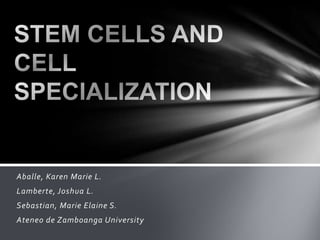
Stem cells
- 1. Aballe, Karen Marie L. Lamberte, Joshua L. Sebastian, Marie Elaine S. Ateneo de Zamboanga University
- 2. Cell Lineages • Stem cell divides by mitosis to yield either 2 daughter cells like itself or one that is a partially progenitor cell • Stem cell is the main cell that reproduces 2 different types of daughter cell • There are 260 or so cell types in the body develop from stem and progenitor cells such as blood cell, connective tissue cell, bone cell, neuron, skin cell and sebaceous gland cells
- 4. STEM CELL VS PROGENITOR CELLS
- 5. Stem Cell Potentialities Totipotent – gives rise to any cell types Pluripotent – gives rise to any cell under a certain cell type Multipotent – gives rise to other types of cell but is limited in its ability to be differentiated Unipotent – gives rise to a certain cell
- 6. STEM CELL POTENTIALITIES DURING EMBRYONIC DEVELOPMENT Organogen esis and so Gastrulation on Multipotent Unipotent cells Blastocyst formation Pluripotent cells Fertilization Totipotent cells
- 7. STEM CELL TECHNOLOGY USING EMBRYOS
- 8. USING EMBRYOS - Stem cells is one type of, “regenerative medicine” - In 1998, a breakthrough occurred when led by James Thomson - SOURCES * all organs (rare) * earliest embryo through the elderly * even from corpses and medical waste (e.g fatty material discarded after liposuction and surgically removed organs.)
- 9. EMBRYONIC STEM (ES) CELLS 2 sources of ES Cells 1. Use of embryos from fertility clinics where couples undergoing in vitro (test tube). 2. Somatic-cell nuclear transfer
- 13. STEM CELL TECHNOLOGY USING CELLS FROM ADULTS
- 14. Stem cells can heal hearts
- 15. Somatic Stem Cell Therapy: Using a Bone Marrow Transplant to Cure Leukemia • A sample of donor bone marrow containing healthy stem cells is introduced into the patient's bloodstream. • Stem cells will migrate into the patient's bone marrow and begin producing new, healthy leukocytes to replace the abnormal cells.
- 16. Peripheral Blood Stem cells • Stem cells from bloodstreams • PBSCs are easier to collect than bone marrow stem cells, which must be extracted from within bones.
- 17. Umbilical Cord Blood Stem Cells Umbilical cord blood stem cell transplants are less prone to rejection than either bone marrow or peripheral blood stem cells.
Notes de l'éditeur
- first developed a technique to isolate and grow human embryonic stem cells in cell culture.- These sources are not considered really promising because of the inability to locate most adult stem cells within the body and successfully grow them in the lab. ( Ex: in bone marrow, out of 10,000 cells, only one is a stem cell
- After being inserted into the egg, the lone (somatic-cell) nucleus is reprogrammed by the host egg cell. The egg, now containing the somatic cell's nucleus, is stimulated with a shock and will begin to divide. After many mitotic divisions, this single cell forms a blastocyst (an early stage embryo with about 100 cells) with almost identical DNA to the original organism
